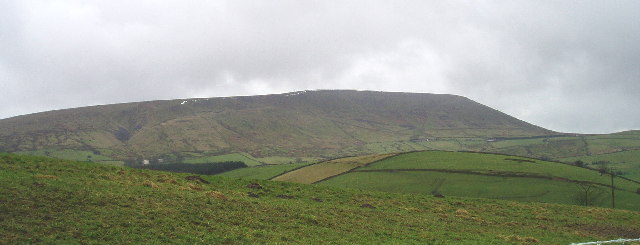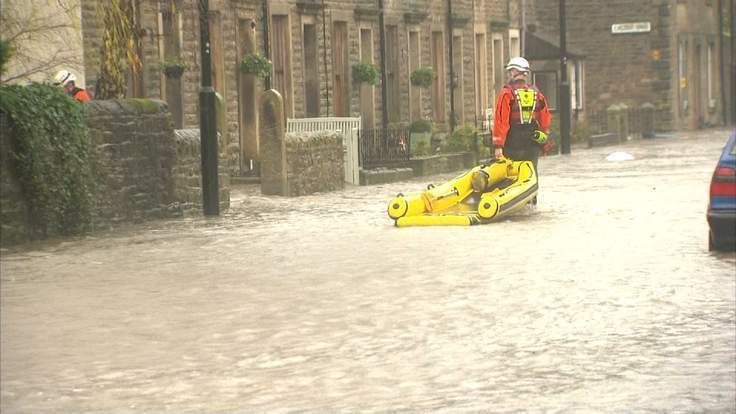|
Wheatley Lane
Wheatley Lane is a village in Pendle, Lancashire, England. It is close to Nelson, Barrowford and Burnley. It lies to the north of the A6068 road, known locally as the Padiham bypass, or "The New Road". Wheatley Lane is an extended village consisting of a ribbon development along 'Wheatley Lane Road' and abuts the sister village of Fence. The present village has now effectively absorbed the original hamlets of Wheatley Lane and Higher & Lower Harpers. Historically, it lies in Old Laund Booth, in the Hundred of Blackburn. Up until Late Mediaeval times it lay in the Forest of Pendle, the hunting preserve of the King. The older properties on the village consist largely of small stone-built cottages, with some later Victorian terraces and some 1950s council properties. Since the 1960s the remaining open fields on either side of the road have been developed for housing. There is unbroken countryside with walking country to the North to Pendle Hill and surrounding areas. There is a ... [...More Info...] [...Related Items...] OR: [Wikipedia] [Google] [Baidu] |
Old Laund Booth
Old Laund Booth is a civil parish in the Pendle district of Lancashire, England. It has a population of 1,459, and contains the villages of Fence and Wheatley Lane. Old Laund Booth was once a township in the ancient parish of Whalley. This became a civil parish in 1866, forming part of the Burnley Rural District from 1894 (until 1974). Until 1898 when the parish was enlarged, part of Goldshaw Booth and a detached area Higham with West Close Booth, divided the township into two parts with Fence in the eastern and Wheatley Lane and Old Laund hall in the western. In 1935 the civil parish of Wheatley Carr Booth was abolished and the area also joined this parish. The parish adjoins the Pendle parishes of Roughlee Booth, Barrowford, Nelson, Brierfield, Reedley Hallows, Higham-with-West Close Booth and Goldshaw Booth. Higher areas of the parish, north-east of the villages are part of the Forest of Bowland Area of Outstanding Natural Beauty (AONB). According to the United Kingdom ... [...More Info...] [...Related Items...] OR: [Wikipedia] [Google] [Baidu] |
Fence, Lancashire
Fence is a village in the civil parish of Old Laund Booth, Pendle, Lancashire, England, close to the towns of Nelson and Burnley. It lies alongside the A6068 road, known locally as the Padiham bypass. The parish (which includes the adjoining village of Wheatley Lane) has a population of 1,586. Fence is a small village along 'Wheatley Lane Road', It abuts the sister village of Wheatley Lane. Because of this, Fence and Wheatley Lane are often referred to together as 'Fence'. The present village now terminates to the west pasSt Anne's church where the new bypass cuts the line of the old road. Fence was in the Hundred of Blackburn. Up until late medieval times, it lay in the Forest of Pendle, the hunting preserve of the King. The name of the village, is derived from the fact that an enclosure was erected in the area, within which the King's deer were kept. This became known as the "Fence", and the community that built up around it over time took the name. In 1507, Henry VII ''"su ... [...More Info...] [...Related Items...] OR: [Wikipedia] [Google] [Baidu] |
Edmund Robinson
Edmund Robinson was an English ten-year-old boy from Wheatley Lane, Lancashire, who sparked a witch-hunt. His story was the inspiration for the 1634 play ''The Late Lancashire Witches''.''Devil Dogs'', p. 26, May 2011, BBC History Magazine ''BBC History Magazine'' is a British publication devoted to both British and world history and aimed at all levels of knowledge and interest. The publication releases thirteen editions a year, one per month and a Christmas special edition, an ... References *# Notes Year of birth missing Year of death missing 17th-century English people English children {{England-bio-stub ... [...More Info...] [...Related Items...] OR: [Wikipedia] [Google] [Baidu] |
Pendle Witches
The trials of the Pendle witches in 1612 are among the most famous witch trials in English history, and some of the best recorded of the 17th century. The twelve accused lived in the area surrounding Pendle Hill in Lancashire, and were charged with the murders of ten people by the use of witchcraft. All but two were tried at Lancaster Assizes on 18–19 August 1612, along with the Samlesbury witches and others, in a series of trials that have become known as the Lancashire witch trials. One was tried at York Assizes on 27 July 1612, and another died in prison. Of the eleven who went to trial – nine women and two men – ten were found guilty and executed by hanging; one was found not guilty. The official publication of the proceedings by the clerk to the court, Thomas Potts, in his ''The Wonderfull Discoverie of Witches in the Countie of Lancaster'', and the number of witches hanged together – nine at Lancaster and one at York – make the trials unusual for England at that ... [...More Info...] [...Related Items...] OR: [Wikipedia] [Google] [Baidu] |
Thomas Whitham
Thomas Whitham VC (11 May 1888 – 22 October 1924) was an English recipient of the Victoria Cross, the highest and most prestigious award for gallantry in the face of the enemy that can be awarded to British and Commonwealth forces. War service On 25 January 1915, Whitham enlisted in the British Army. He was 29 years old, and a private in the 1st Battalion, Coldstream Guards, during the First World War when the following deed took place for which he was awarded the VC. On 31 July 1917 at Pilckem near Ypres, Belgium, during an attack an enemy machine-gun was seen to be enfilading the battalion on the right. Private Whitham on his own initiative immediately worked his way from shell-hole to shell-hole through our own barrage, reached the machine-gun and, although under very heavy fire captured it, together with an officer and two other ranks. This bold action was of great assistance to the battalion and undoubtedly saved many lives. Post war After the war he became a bricklaye ... [...More Info...] [...Related Items...] OR: [Wikipedia] [Google] [Baidu] |
Pendle Hill
Pendle Hill is in the east of Lancashire, England, near the towns of Burnley, Nelson, Colne, Brierfield, Clitheroe and Padiham. Its summit is above mean sea level. It gives its name to the Borough of Pendle. It is an isolated hill in the Pennines, separated from the South Pennines to the east, the Bowland Fells to the northwest, and the West Pennine Moors to the south. It is included in a detached part of the Forest of Bowland Area of Outstanding Natural Beauty. History The name "Pendle Hill" combines the words for hill from three different languages (as does Bredon Hill in Worcestershire). In the 13th century it was called ''Pennul'' or ''Penhul'', apparently from the Cumbric ''pen'' and Old English ''hyll'', both meaning "hill". The modern English "hill" was appended later, after the original meaning of Pendle had become opaque. A Bronze Age burial site has been discovered at the summit of the hill. There is an ancient local legend that the Devil once jumped from Hameld ... [...More Info...] [...Related Items...] OR: [Wikipedia] [Google] [Baidu] |
Forest Of Pendle
The Forest of Pendle is the name given to an area of hilly landscape to the east of Pendle Hill in eastern Lancashire, roughly defining the watershed between the River Ribble and its tributary the River Calder. The forest is not identical to the modern local government district of Pendle, which is larger. And in fact the modern version of the forest has come to contain areas to the north and east of Pendle Hill which are partly in the district of Ribble Valley. The area is not a forest in the modern sense of being heavily wooded, and has not been so for many centuries. Historically a somewhat larger area than the modern forest was one of the several royal forests of the area, under the control of Clitheroe Castle, or Honour of Clitheroe. Over its history, the forest has gone from being protected and regulated as a medieval royal forest, to being labelled as an Area of Outstanding Natural Beauty. Medieval history In 1086, at the time of the Domesday Book, Pendle forest was part ... [...More Info...] [...Related Items...] OR: [Wikipedia] [Google] [Baidu] |
Whalley, Lancashire
Whalley is a large village and civil parish in the Ribble Valley on the banks of the River Calder in Lancashire, England. It is overlooked by Whalley Nab, a large wooded hill over the river from the village. The population of the civil parish was 2,645 at the census of 2001, and increased to 3,629 at the census of 2011. The main road through Whalley is King Street, which leads through to Clitheroe Road. Neighbouring Whalley are the small villages of Wiswell, Billington, Barrow, and Read. Close by is Downham village and Pendle Hill which was made famous in William Harrison Ainsworth's book ''The Lancashire Witches''. History Portfield Hillfort also known as Planes Wood Camp, thought to date from late Bronze Age or Iron Age, is located on a slight promontory overlooking the valley of the River Calder southeast of the town. It is one of over 140 Scheduled monuments in Lancashire. Flooding Whalley was severely affected by flooding in December 2015. Hundreds of homes were dama ... [...More Info...] [...Related Items...] OR: [Wikipedia] [Google] [Baidu] |
Borough Of Pendle
Pendle is a local government district and borough of Lancashire, England. It adjoins the Lancashire boroughs of Burnley and Ribble Valley, the North Yorkshire district of Craven and the West Yorkshire boroughs of Calderdale and Bradford. It has a total population of (). Early history The name Pendle comes from the Cumbric word 'Pen' meaning hill (or head), a reference to Pendle Hill. Hence the name of the modern district derives from the prominent landmark at the west of the district, which already in the Middle Ages gave its name to the royal forest which spread to its east. Pendle Forest is still the name of a significant rural part of the district, though it has long ago ceased being a forest. The ancient lordship of Pendle Forest has been under the Honour of Clitheroe since medieval times, and a title continues to be held by a modern version, the Barons Clitheroe. Witch trials The area is closely associated with the trials of the Pendle witches, among the most notoriou ... [...More Info...] [...Related Items...] OR: [Wikipedia] [Google] [Baidu] |
Padiham
Padiham ( ) is a town and civil parish on the River Calder, about west of Burnley, Lancashire, England. It forms part of the Borough of Burnley. Originally by the River Calder, it is edged by the foothills of Pendle Hill to the north-west and north-east. The United Kingdom Census 2011 gave a parish population of 10,098, estimated in 2019 at 10,138. History No prehistoric or Roman sites have been found in the built-up area. Padiham, though a name of Anglo-Saxon origin, is not recorded in the 1086 Domesday Book.Historic Town Assessment Report, Padiham, Lancashire County Council, May 2005, includes several old maps of the town and location ... [...More Info...] [...Related Items...] OR: [Wikipedia] [Google] [Baidu] |
A6068 Road
List of A roads in zone 6 in Great Britain Great Britain is an island in the North Atlantic Ocean off the northwest coast of continental Europe. With an area of , it is the largest of the British Isles, the largest European island and the ninth-largest island in the world. It is ... starting east of the A6 and A7 roads, and west of the A1 (road beginning with 6). Single- and double-digit roads Triple-digit roads Four-digit roads (60xx) Four-digit roads (61xx and higher) References {{UK road lists 6 6 ... [...More Info...] [...Related Items...] OR: [Wikipedia] [Google] [Baidu] |



